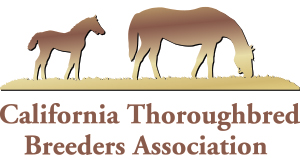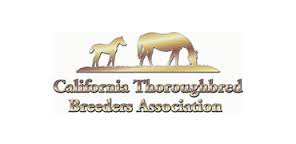By John Cherwa
Los Angeles Times
ARCADIA, Calif. (Feb. 1, 2016) — The numbers are startling, the reality is staggering.
If California’s first-class horse racing tracks are to survive, they are in large part dependent on a third-place breeding program.
A track such as Santa Anita needs inventory, and if it didn’t have California breds running, it probably would be racing only two days a week. Under that scenario, it wouldn’t be long before the track would be turned into a residential or retail development. Or a sports stadium.
Doug Burge, president of the California Thoroughbred Breeders Assn., took up the challenge of figuring out a way to essentially bribe people to breed, buy and race here. “We have these carrots we put out there to give people a reason to breed in California,” he said.
If you win a maiden special weight race with a Cal bred in Southern California, the owner gets a check for $17,500 in addition to the purse money. An owner winning in Northern California gets $10,000.
The incentives were necessary to revive a breeding program that had gone into free fall after the 2008 financial crisis. It was a nationwide problem but acute in California because it had some of the country’s marquee tracks, such as Santa Anita and Del Mar, which were having trouble filling races.
The disparity in breeding in the U.S. is enormous, and California is dwarfed by a state that has one-eighth its population. In 2014, Kentucky bred 47.1% (16,710) of all the mares in the U.S. California accounted for 7.1% (2,518). The top stallion in Kentucky, Tapit, has a stud fee of $300,000. The top fee in California belongs to Square Eddie at $25,000.
Burge contests California’s third-place national standing, saying that the state is “neck and neck” with Florida, although the stats still slightly edge the other way. A major difference is that Florida breds often leave the state, Cal breds don’t.
“If they can run, about 90% [of Cal breds] are going to run in California,” Burge said. “Kentucky breds are going all over the world. It’s an international market. This is a regional market.”
Burge might be low on his estimate.
Saturday is Sunshine Millions day at Santa Anita, with a 10-race program made up entirely of Cal breds and eligible California-sired horses running for more than $1.25 million in purses.
There are 88 horses scheduled to run with 988 lifetime starts. Of those, 97.6% (964) of their races have been in California and 84.6% (836) have been at a Southern California track. Only seven of the 88 horses on Saturday’s card have ever run outside of the state.
One of the most interesting races is the California Cup Derby for 3-year-olds. It was won two years ago by California Chrome, launching his horse-of-the-year campaign in which he won the Kentucky Derby and Preakness Stakes.
California Chrome and Tiznow, the only horse to win two Breeders’ Cup Classics, are considered the two best California breds. But, when Chrome retires at the end of the year, he will be shipped to Kentucky for breeding. Tiznow stands in Kentucky with a $60,000 stud fee.
As successful as the California breeding incentive program has been, the economics point to a glass ceiling. Win too much money and you leave the state to breed.
“The problem arises if they [stallions] are valuable,” Burge said. “Once you hit about $20,000 [stud fee], you limit the number of mares that are in that pool to breed to.”
California Chrome was the result of a $2,500 stud fee (Lucky Pulpit) and an $8,000 mare (Love The Chase). After Chrome’s success, Lucky Pulpit’s fee has gone to $7,500. As for Love The Chase, she has been sent to Kentucky to breed with Tapit.
The favorite in Saturday’s California Cup Derby is Smokey Image, unbeaten in five starts. He is one of six California breds whose owners have paid the $600 nomination fee for the Kentucky Derby. There were 368 horses nominated, 283 of them were Kentucky breds.
One criticism facing the incentive program is that bettors are turned off by the number of restricted (Cal bred) races as opposed to open races.
The state breeding programs “are of a huge economic importance,” said Alan Balch, executive director of the California Thoroughbred Trainers. “But you have to balance that against what the public wants, which is good betting propositions and the best horses competing against each other [in open races].”
Balch made it clear he appreciates the upside.
“The breeders have done a great job providing incentives for regrowing California racing,” he said. “We would be out of business without them. We just wish there were more horses to race.”
Gary Young, an owner and private clocker who advises clients on the potential of horses, speaks to the economic realities of the sport.
“The break-even point is somewhere around $50,000, depending on the trainer,” Young said about the yearly costs of keeping a horse at the track. “So, it makes more sense to keep [horses] here and run them in restricted races [for more money against lesser competition] than to take them out of town for smaller purses.”
Young has a different view of the betting opportunities.
“With the emergence of superfectas and gimmicks, bettors just want full fields,” Young said. “I imagine there is more money bet on a 10-horse open race than a Cal-bred race, but I’m not sure the difference is significant.”
Whatever your opinion, the Cal bred incentive program seems to be working on most levels. And the people who must carry out the racing seem just fine with it.
“The Cal bred has taken huge leaps forward in the last 15 years,” said Hall of Fame jockey Gary Stevens, who will be aboard three Cal breds Saturday. “Cal breds are not the same Cal breds of 20 years ago. It’s a great investment. I don’t even look to see if it’s a Cal bred or Kentucky bred when I’m climbing on one because we have some good ones.”
john.cherwa@latimes.com


